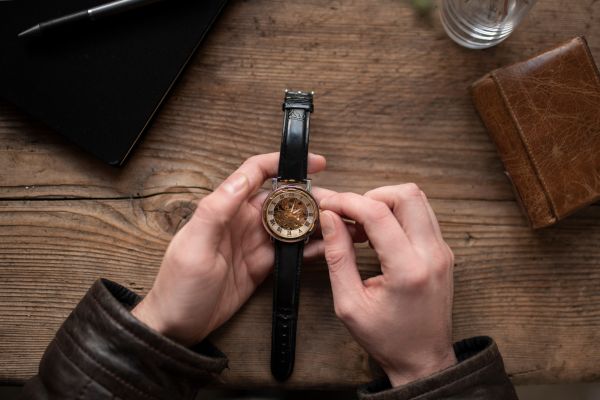Summary :
- Should you wind an automatic watch?
- When should it be done manually?
- How many turns to wind an automatic watch?
- The 3 steps to winding an automatic watch
- Precautions to take
Automatic watch winding techniques are essential to ensure their accuracy and extend their life. Knowing when and how to wind them is important to keep them running smoothly.
Should you wind an automatic watch?
The winding of an automatic watch is based on a rotor that is activated by the natural movements of the wrist, thus winding the mainspring. This mechanism stores the energy generated by the movements, allowing the watch to run continuously, without daily manual intervention. When the watch is worn, the rotor turns freely and transmits energy to the mainspring, thus ensuring sufficient autonomy. On the other hand, after a long period of inactivity, it may be necessary to manually wind the watch to restart the mechanism and ensure its proper functioning .
When should it be done manually?
Despite their design, automatic watches may require manual winding in certain situations.
When is manual winding necessary?
After a prolonged period of inactivity, when the watch has not been worn for more than 24 to 48 hours, the mainspring may run out of energy. In this case, manual winding is necessary to restart the mechanism.
Importance of power reserve
To ensure an optimal power reserve, occasional manual winding can be useful, even if the watch is worn regularly. The power reserve corresponds to the length of time a watch can run without being wound. Ensuring a sufficient energy reserve is particularly important when daily activity does not generate enough movement to power the watch properly.
How many turns to wind an automatic watch?

The number of turns required to wind an automatic watch depends on the model. As a general rule, for a standard watch, 20 to 30 turns are sufficient for a complete winding. More complex watches, including watch complications , may require up to 40 turns. For specific recommendations for your watch, it is important to consult the user manual or contact the manufacturer.
The 3 steps to winding an automatic watch
Manually winding an automatic watch is an operation that requires precision to avoid damaging the mechanism.
1. Remove the watch from the wrist
Removing the watch from the wrist helps reduce the pressure on the crown and ensures uniform winding without the risk of distorting the mechanism. This helps reduce the pressure on the crown and ensures uniform winding without the risk of distorting the mechanism.
2. Identify the position of the crown
Identifying the position of the crown is essential. The crown is usually located on the right side of the case. Make sure it is in the initial position, i.e. pushed against the case, before reassembling.
3. Turn the crown
Turning the crown gently clockwise, using your thumb and index finger, will wind the watch correctly. Perform between 20 and 40 turns depending on the model for complete winding. Increased resistance indicates that the spring is fully tensioned.
Precautions to take

When winding your automatic watch, it is important to take certain precautions to avoid any damage to the mechanism.
Avoid over-winding
To preserve the longevity and proper functioning of your watch, avoid overwinding it. Some watches are equipped with a device to prevent overwinding, but it is still best to stop as soon as you feel resistance.
Respect for adjustment time slots
Some watches have a critical period, often referred to as the " death zone ", between 9pm and 3am. During this time period, it is strongly recommended not to adjust the date or time, as this could cause damage to the watch mechanism. It is therefore important to take this period into account and only make adjustments outside of these hours.
By mastering the process of winding your automatic watch, you not only ensure its accuracy but also its longevity. Follow the steps and precautions carefully to protect the complex mechanism of your watch and fully enjoy its elegance and performance.


How to maintain an automatic watch?
What is the death zone in watchmaking?